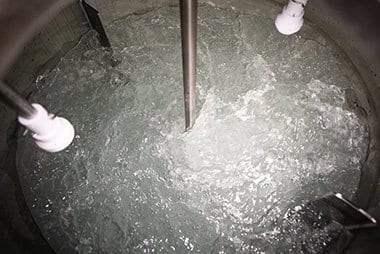Liquid Mixing Systems for Industrial Manufacturing Applications

There are three primary types of liquid mixing systems with two different approaches to mixing. In this blog, you’ll learn more about these different mixing systems, what each is used for, and how they work so you can choose the right mixing skid that will provide your company with optimal product quality.
What Are Liquid Mixing Systems?
A liquid mixing system is any system that mixes some substance into liquid to form an emulsion, slurry, or other homogenous mixture. These substances may be solids, powders, other liquids, or even gas. Which blending technique you use for these mixtures depends on what components you want to mix together.
You do liquid mixing at home every day, even if you don’t realize it. When you make a smoothie in the morning, wash your clothes, and even fix your kids’ pudding for an afternoon snack, you’re using liquid mixing on a small scale. But large industries need mixing skids that are capable of producing homogenous mixtures consistently.
Types of Industrial Liquid Mixing Systems and Their Uses
Solid-Liquid Mixing
A solid-liquid mixing system is a recirculating system designed to dissolve solids into liquid. The system begins recirculating the liquid while the solids are added into the hopper of the blender. You can connect several preparation tanks together using a manifold if you like.
Solid-liquid mixing can be used in a wide variety of industries, including food processing, cosmetics, pharmaceutical, and specialty chemical applications. The food processing industry may use them to dissolve sugar into beverages, reconstitute milk, produce syrup, prepare brine, or incorporate yogurt remixtures. It can also be used in ice cream production and any other application which requires a solid to be mixed into a liquid.
Powder-Liquid Mixing
Powder-liquid mixing systems are designed to incorporate powders and liquids into homogeneous mixtures. Creating a truly blended substance can be difficult, and many different viscosities may be required. You have to have your product recirculating at a very high velocity and use mechanical and hydraulic shearing methods to ensure that there are no clumps of aggregate and that you have a homogenous blend.
Powder-liquid mixing may have applications in industries ranging from agriculture to food processing. They are often used in preparing pesticides and fertilizers. But they may also be used to prepare flour and starch slurries, prepare brines, suspend bentonites in pigment, and pre-mix milk-based desserts.
Liquid-Liquid Mixing
Liquid-liquid mixing systems are used to combine two different liquids into one consistent mixture. These systems usually use agitators similar to the ones you see in a top-loaded washing machine. You may also see emulsifiers that use pressure and isolated systems to mix liquids that naturally do not want to mix, such as oil and water.
Liquid-liquid mixing is crucial to making beverages and producing biodiesel. They may also be used to make creams and lotions for the cosmetics industry and mulch and dye coatings for the agricultural industry. And if you’ve ever shopped for paint at a hardware store, you’ve seen liquid-liquid mixing in action when they mixed your paint for you.
Continuous Liquid Mixing VS Batch Liquid Mixing
Continuous Liquid Mixing
Continuous liquid mixing is a method of blending that generates a continuous stream of whatever your final product is. So rather than mixing one batch of liquid with one batch of solid, powder, or liquid, you have a continuous flow of components going into the system and a continuous stream of homogeneous mixture coming out the other end. These mixers may still use different mixing stages to ensure that you get a smooth, incorporated product.
Continuous liquid mixing can be helpful in situations where you need a completely identical product every time. The textile industry may use this technology to ensure that dye lots stay the same, and the food processing industry can use it to make sure they have evenly hydrated dough. In addition to improving product consistency, it can also up production since it enables you to produce more from one mixer.
Batch Liquid Mixing
Batch liquid mixing systems, on the other hand, mix only one batch of your product at a time. Think of this like the process you use to make cookies in your home. All of the ingredients are carefully measured out and then they’re added to the mixer at the appropriate times in the process to make one batch of your product.
Batch liquid mixing can be very important for industries that are creating multiple different products. The paint and fragrance industries, for example, need to be able to produce different batches of different products. And with proper measuring practices, batch mixing can produce results nearly as uniform as continuous mixing.
Learn More About Liquid Mixing Skids
Liquid mixing systems are involved in just about every area of our lives. From the soap we use to clean our bodies and our homes to the food we eat, to the clothes we wear, liquid mixers have probably been involved somewhere in the process. And if you run a factory, knowing which liquid mixing system you need can help you produce a uniform product that will live up to your quality standards.
